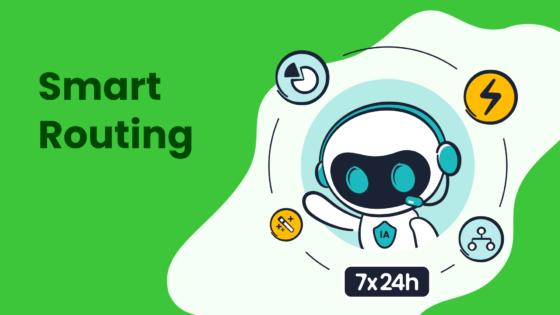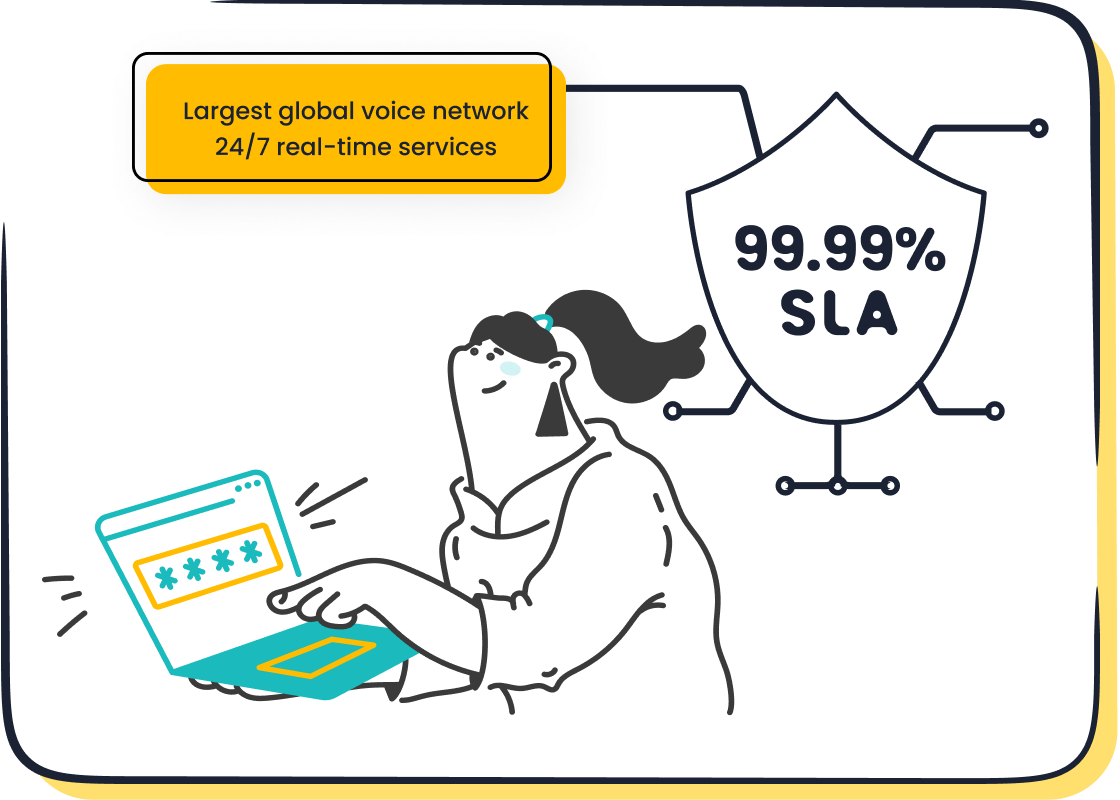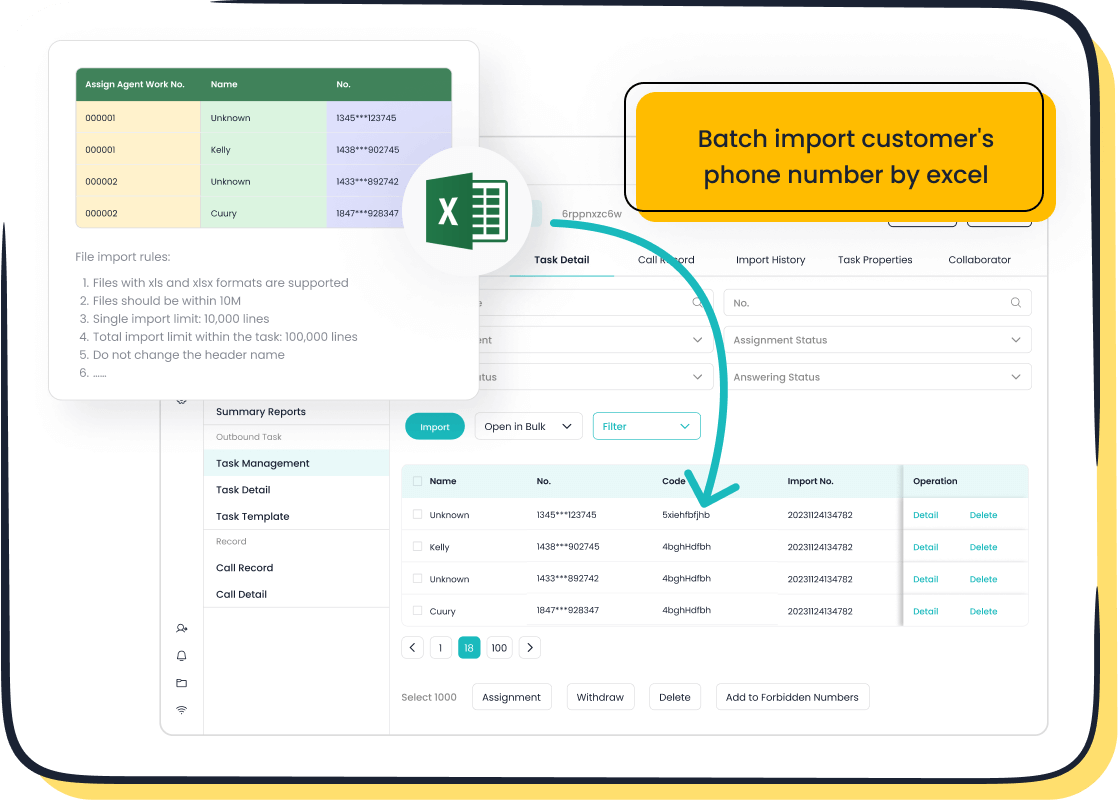10 Best Practices for Outbound Campaign Management

Outbound campaign management plays a vital role in driving customer engagement and fueling business growth. When done right, it helps you connect with potential customers, build trust, and achieve your marketing goals efficiently. However, many businesses face challenges like limited budgets or resource constraints. By focusing on segmentation, automation, and crafting compelling messages, you can overcome these hurdles and maximize your campaign's impact.

Tools like Sobot's Voice/Call Center make it easier to streamline processes and maintain consistent messaging. These best practices not only save time but also ensure your efforts resonate with your audience, leading to better results.
Set SMART Goals for Outbound Campaign Success
Setting SMART (Specific, Measurable, Achievable, Relevant, Time-bound) goals is the foundation of successful outbound campaign management. Clear goals and objectives help you stay focused, measure progress, and achieve better results.
Define Clear Objectives
Align goals with business outcomes
Your outbound sales efforts should directly support your broader business objectives. For example, if your company aims to boost revenue, your outbound campaign might focus on generating high-quality leads or increasing conversion rates. Aligning your goals ensures that every action contributes to measurable business growth.
Establish key performance indicators (KPIs)
KPIs act as your campaign's compass. They help you track progress and identify areas for improvement. For instance, you might monitor metrics like the number of leads generated, email open rates, or call conversion rates. These indicators provide actionable insights, ensuring your outbound sales marketing tactics remain effective.
Use Data to Set Realistic Targets
Leverage historical performance data
Data is your best friend when setting achievable goals. Look at past campaigns to understand what worked and what didn’t. For example, if your previous email campaign had a 30% open rate, aim to improve it to 40% by enhancing segmentation and personalization. Using historical data helps you set realistic benchmarks.
Monitor progress against benchmarks
Tracking your progress is just as important as setting goals. Use tools like Sobot’s Voice/Call Center to monitor call data in real-time and adjust your strategy as needed. For example, if your goal is to generate 500 qualified leads per month, regularly compare your current performance against this target. This approach ensures you stay on track and make data-driven decisions.
Here’s a quick look at some SMART goals that have proven effective in outbound campaigns:
| SMART Goal Example | Description |
|---|---|
| Double website traffic | Increase traffic by publishing 5 blog posts weekly over 12 months. |
| Improve conversion rate | Boost lead to customer conversion by 5% for the quarter. |
| Generate leads | Achieve 500 qualified leads per month via PPC campaigns. |
| Strengthen backlinks | Obtain 50 backlinks from authoritative domains by month-end. |
| Boost Instagram engagement | Increase engagement from 4% to 5% in 30 days. |
By setting SMART goals, you create a roadmap for success. Whether you aim to generate new leads or improve customer retention, these best practices ensure your outbound campaign management efforts deliver measurable results.
Segment Your Audience for Targeted Outreach
Understanding your audience is the cornerstone of effective outbound campaign management. By segmenting your audience, you can deliver messages that resonate, leading to better engagement and higher-quality leads.
Create Detailed Customer Personas
Use demographic and behavioral data
To create accurate customer personas, start by gathering key details about your audience. Look at demographic information like age, gender, education, and location. Combine this with behavioral data, such as purchasing habits, brand loyalty, and decision-making processes. For example, if you notice a segment of customers frequently purchasing during sales events, you can target them with exclusive offers during your next campaign.

Additionally, psychographic data like lifestyle, values, and interests can help you understand what motivates your audience. Tools like Sobot’s Voice/Call Center can assist in collecting and analyzing this data, giving you a clearer picture of your ideal customer.
Identify high-value customer segments
Not all leads are created equal. Focus on identifying high-value segments that align with your campaign goals. Use customer surveys, interviews, and analytics to spot patterns and common themes. For instance, if your goal is lead generation, prioritize segments with a history of engaging with your marketing efforts. By targeting these groups, you maximize your campaign’s efficiency and ROI.
Tailor Messaging to Each Segment
Personalize communication for better engagement
Personalization is no longer optional—it’s essential. Studies show that 74% of B2B buyers are more likely to purchase when their experience feels personalized. Address specific pain points or challenges faced by each segment. For example, if you’re targeting small business owners, highlight how your product saves time and reduces costs. This approach makes your message more relevant and engaging.
Prioritize segments based on campaign goals
Your campaign goals should guide your focus. If your objective is to nurture existing leads, prioritize segments that have already shown interest in your product. On the other hand, for lead generation, target new audiences who fit your ideal customer profile. Tailored messaging ensures you connect with the right people at the right time, boosting your campaign’s success.
By segmenting your audience and customizing your outreach, you can turn outbound campaigns into powerful tools for lead generation and customer engagement. These best practices help you build stronger connections and achieve better results.
Craft Scripts and Messaging for Outbound Calling Campaigns
Creating a compelling script is essential for a successful outbound calling campaign. Your messaging should resonate with your audience, address their needs, and highlight the value you bring. By personalizing the interaction and focusing on providing value, you can build rapport and turn prospects into leads.
Personalize Communication
Use customer data to address specific needs
Personalization is the cornerstone of effective communication. Use customer data to tailor your approach. For instance, referencing a prospect’s previous interactions or mentioning their specific challenges shows that you’ve done your homework. This makes your outreach feel more genuine and less like a generic sales pitch.
| Strategy | Description |
|---|---|
| Personalization | Tailor your approach to each customer by using their name, referencing past interactions, and showing an understanding of their specific needs and interests. This demonstrates that you value them as individuals, not just as another number on a call list. |

When you personalize the interaction, you increase the likelihood of a positive response. Tools like Sobot’s Voice/Call Center can help you gather and analyze customer data, making it easier to craft targeted messages.
Avoid generic or overly salesy language
Nobody likes feeling like they’re just another number on a call list. Avoid using generic scripts that sound robotic or overly pushy. Instead, focus on building rapport by speaking naturally and addressing the customer’s unique situation. For example, instead of saying, “Our product is the best on the market,” try, “I noticed you’ve been exploring solutions for [specific challenge]. Here’s how we can help.” This approach fosters trust and keeps the conversation engaging.
Highlight Value Propositions
Focus on benefits over features
When presenting your value proposition, focus on the tangible outcomes your product or service delivers. Instead of listing features, explain how those features solve problems or improve the customer’s life. For example, rather than saying, “Our software has advanced analytics,” you could say, “Our analytics tools help you identify high-value leads faster, saving you time and boosting your ROI.” This shift in focus makes your message more relatable and impactful.
Address common customer pain points
Your script should directly address the challenges your audience faces. During the qualifying stage, identify their pain points and tie your solution to those needs. For instance, if a prospect struggles with managing outbound campaigns efficiently, highlight how Sobot’s Voice/Call Center automates tasks and provides real-time insights. This not only demonstrates your understanding of their problems but also positions your offering as the ideal solution.
By crafting personalized and value-driven scripts, you can elevate your outbound calling campaign. These best practices ensure your messaging resonates with your audience, leading to better engagement and more qualified leads.
Leverage Technology for Efficient Outbound Campaign Management
Technology plays a crucial role in optimizing outbound call center campaigns. By leveraging the right tools, you can streamline processes, improve efficiency, and deliver better results. Here’s how you can use technology to take your campaigns to the next level.
Use Sobot's Voice/Call Center for Automation

Automate outbound calling tasks
Automation is a game-changer for outbound call center campaigns. Tools like Sobot’s Voice/Call Center allow you to automate repetitive tasks, such as dialing numbers or scheduling follow-ups. This frees up your team to focus on building relationships and closing deals. For example, Sobot’s bulk outbound task feature lets you assign leads to agents based on priorities, ensuring no opportunity slips through the cracks. Automation also ensures timely communication, which is critical for maintaining customer interest.
Monitor and analyze call data in real-time
Real-time analytics provide valuable insights into your campaign’s performance. With Sobot’s monitoring tools, you can track metrics like call duration, response rates, and conversion rates as they happen. This data helps you identify what’s working and where adjustments are needed. For instance, if a particular script isn’t resonating with your audience, you can tweak it immediately to improve engagement. Real-time analysis ensures your campaigns stay agile and effective.
Integrate CRM and Analytics Tools
Track customer interactions seamlessly
Integrating your outbound call center campaigns with a CRM system like Salesforce or HubSpot enhances productivity. It allows you to track every customer interaction, from initial contact to final sale, in one place. This ensures your agents have all the information they need to personalize conversations and build trust. For example, knowing a lead’s previous inquiries or preferences can help you tailor your pitch, increasing the chances of conversion.
Use analytics to refine strategies
Analytics tools provide a deeper understanding of your campaign’s impact. By analyzing data from your CRM, you can measure effectiveness beyond basic metrics like email open rates. For instance, you can track how many leads converted into paying customers and identify patterns in purchasing behavior. These insights enable you to refine your strategies and focus on what drives results.
Optimize Multichannel Outreach
Combine calls, personalized emails, and social media
A multichannel approach ensures you reach your audience where they’re most active. Combine outbound calls with personalized emails and social media outreach to create a cohesive campaign. For example, you could follow up a call with an email summarizing the conversation or share a case study on LinkedIn to reinforce your value proposition. This strategy keeps your brand top-of-mind and increases engagement.
Ensure consistent messaging across channels
Consistency is key in multichannel campaigns. Your messaging should align across all platforms to avoid confusing your audience. For instance, if your email highlights a product’s cost-saving benefits, your call script should reinforce the same point. Tools like Sobot’s Voice/Call Center make it easy to manage messaging across channels, ensuring a seamless experience for your leads.
By leveraging technology, you can transform your outbound call center campaigns into efficient, high-performing operations. These best practices help you save time, improve engagement, and achieve better results.
Train and Empower Your Outbound Sales Team
Your outbound sales team is the backbone of your campaigns. When they’re well-trained and motivated, they can turn potential leads into loyal customers. By investing in their growth, you’ll see better results and a more engaged team.
Provide Comprehensive Training
Teach effective communication techniques
Effective communication is the key to converting leads. Train your team to actively listen, ask open-ended questions, and adapt their tone based on the customer’s personality. For example, role-playing common scenarios can help them handle objections confidently. Interactive methods like video-based learning or gamification make training more engaging and memorable.
Familiarize teams with tools like Sobot's Voice/Call Center
Equip your team with the right tools to streamline their work. Sobot’s Voice/Call Center, for instance, simplifies outbound calling by automating repetitive tasks and providing real-time analytics. Show your team how to use features like call tracking and smart routing to manage leads efficiently. When your team knows how to leverage these tools, they’ll spend less time on logistics and more time building relationships.
Encourage Continuous Improvement
Offer regular coaching and feedback
Feedback is a powerful motivator. Schedule regular one-on-one sessions to review performance and discuss areas for improvement. Use data from tools like Sobot’s analytics to provide actionable insights. For example, if a team member struggles with closing leads, you can analyze call recordings to identify gaps and offer targeted coaching.
Share success stories and best practices
Celebrate wins to inspire your team. Share stories of successful campaigns or highlight how a team member turned a challenging lead into a sale. Peer learning sessions are another great way to exchange tips and strategies. For instance, a rep who excels at objection handling can share their approach with the team. This fosters collaboration and keeps everyone motivated to improve.
By focusing on training and continuous improvement, you empower your team to excel in outbound sales. A well-prepared team not only boosts your campaign’s success but also creates a positive work environment.
Monitor and Optimize Campaign Performance
Monitoring and optimizing your outbound campaigns is essential for achieving better results. By tracking key metrics and conducting regular reviews, you can identify what’s working and make data-driven adjustments to improve performance.
Track Key Metrics
Measure conversion rates and response times
Tracking the right metrics gives you a clear picture of your campaign’s success. Start by focusing on your conversion rate, which tells you how many leads took the desired action, like signing up for a demo or making a purchase. For example, if your outbound sales campaign targets 1,000 leads and 100 convert, your conversion rate is 10%.

Response times are equally important. Faster responses often lead to higher engagement. Tools like Sobot’s Voice/Call Center can help you monitor these metrics in real-time, ensuring your team stays on top of every opportunity.
Use dashboards for real-time insights
Dashboards make it easy to visualize your campaign’s performance. They provide real-time insights into key metrics like click-through rates, bounce rates, and customer acquisition costs. For instance, if you notice a high bounce rate, it might indicate that your messaging isn’t resonating with your audience. Adjusting your approach based on these insights can significantly improve your results.
Here’s a quick look at some essential metrics to track:
| Metric | Description |
|---|---|
| Conversion Rate | Percentage of recipients who took the desired action after engaging with the campaign. |
| Click-Through Rate (CTR) | Measures how many people clicked on a link in your email or ad, indicating content engagement. |
| Bounce Rate | Percentage of visitors who leave the site after viewing just one page, hinting at targeting issues. |
| Lead Generation Rate | Effectiveness of campaigns in acquiring new leads, essential for market expansion. |
| Cost Per Lead (CPL) | Cost of acquiring a new lead, helping manage budget efficiency. |
Conduct Regular Reviews
Identify underperforming areas
Regular reviews help you spot areas that need improvement. For example, if your conversion rate is lower than expected, analyze your call scripts or email templates to see where prospects lose interest. Sobot’s analytics tools can provide detailed reports, making it easier to pinpoint underperforming areas in your outbound sales efforts.
Adjust strategies based on data analysis
Once you’ve identified the gaps, tweak your strategies to address them. If your lead generation rate is low, consider refining your audience segmentation or updating your messaging. Real-time data from tools like Sobot’s Voice/Call Center allows you to test changes and measure their impact quickly. This iterative approach ensures your campaigns stay effective and aligned with your marketing goals.
Pro Tip: Regularly reviewing your campaign performance not only improves results but also helps you stay ahead of market trends. Small adjustments can lead to significant gains over time.
By tracking key metrics and conducting regular reviews, you can optimize your campaigns for better performance. These practices ensure you’re always moving closer to your sales and marketing objectives.
Ensure Compliance and Ethical Practices in Outbound Campaigns
Compliance and ethical practices are essential for building trust and maintaining a positive reputation in outbound sales. By adhering to legal regulations and being transparent with your customers, you can ensure your campaigns remain effective and credible.
Adhere to Legal Regulations
Follow Do Not Call (DNC) lists

Respecting DNC lists is non-negotiable. These registries protect individuals who don’t want to receive telemarketing calls. Violating these rules can lead to hefty fines and damage your brand’s reputation. For example, the U.S. Federal Trade Commission enforces penalties of up to $43,792 per violation. Tools like Sobot’s Voice/Call Center can help you manage compliance by automatically cross-checking numbers against DNC lists, ensuring your outreach stays within legal boundaries.
Comply with data privacy laws
Data privacy laws vary by region, but they all aim to protect consumer information. Whether it’s the CAN-SPAM Act for email marketing or the Telephone Consumer Protection Act (TCPA) for telemarketing, you must follow these regulations to avoid legal trouble. Here’s a quick overview of key laws:
| Regulation | Description |
|---|---|
| CAN-SPAM Act | Ensures recipients can opt-out of emails and prohibits misleading subject lines. |
| TCPA | Restricts telemarketing calls and automated systems. |
| DNC Registry | Prevents calls to individuals who’ve opted out. |
| UCPA | Grants consumers rights over their personal data. |
Staying informed about these laws helps you protect your business and customers.
Maintain Transparency with Customers
Clearly communicate campaign intentions
Honesty goes a long way in outbound marketing. Let your customers know what to expect from your products or services. For instance, if you’re offering a free trial, explain the terms upfront. This builds trust and sets the stage for meaningful conversations.
Avoid misleading or aggressive tactics
Nobody likes feeling pressured or misled. Instead of exaggerating benefits, focus on empowering your customers with accurate information. Share resources like how-to guides or pricing details to help them make informed decisions. For example, if you’re promoting Sobot’s Voice/Call Center, highlight its real-time analytics and automation features without overpromising results.
Pro Tip: Engaging in transparent and ethical practices not only improves customer satisfaction but also strengthens your brand’s credibility.
Overcome Common Challenges in Outbound Campaign Management
Outbound campaigns often face hurdles like customer resistance and team burnout. Tackling these challenges head-on can make your campaigns more effective and sustainable.
Address Customer Resistance
Use empathy to build trust
Empathy is your secret weapon when dealing with hesitant prospects. Instead of diving straight into a pitch, take time to understand their concerns. For instance, if a prospect mentions budget constraints, acknowledge their situation and offer a solution that aligns with their needs. This approach builds trust and opens the door for meaningful conversations.
Common objections in outbound sales include:
- Price Objections: Prospects may feel your product is too expensive. Shift the focus to the value it delivers, like saving time or increasing efficiency.
- Budget Constraints: Some prospects might claim they lack funds. Highlight how your solution can address their cash flow issues in the long run.
- Competition: If they’re already working with another vendor, emphasize your unique benefits. For example, Sobot’s Voice/Call Center offers real-time analytics and automation, which can outperform manual processes.
By addressing objections with empathy and tailored solutions, you can turn resistance into opportunities.
Offer solutions to objections
When objections arise, don’t see them as roadblocks. Instead, treat them as opportunities to showcase your product’s strengths. For example, if a prospect hesitates due to price, explain how your solution reduces operational costs or boosts ROI. Using tools like Sobot’s Voice/Call Center, you can even share real-time data to back up your claims. This proactive approach not only resolves concerns but also positions you as a trusted advisor.
Prevent Team Burnout
Rotate responsibilities to maintain engagement
Repetition can lead to disengagement. Rotating tasks among your team keeps things fresh and prevents monotony. For instance, let one agent focus on lead generation while another handles follow-ups. Tools like Sobot’s Voice/Call Center simplify task management, making it easy to assign roles and track progress. This strategy keeps your team motivated and ensures consistent performance.
Recognize and reward team efforts
Acknowledging hard work goes a long way in boosting morale. Celebrate milestones, whether it’s closing a big deal or achieving a monthly target. Small gestures like shoutouts during team meetings or gift cards can make a big difference. Additionally, fostering a culture of communication helps your team feel supported. Encourage regular breaks and promote self-care practices like exercise and proper nutrition. These steps create a healthier, more productive work environment.
By addressing customer resistance and preventing burnout, you can create a more resilient outbound marketing strategy. These practices not only improve campaign outcomes but also foster a positive and motivated team.
Foster Long-Term Customer Relationships
Building long-term customer relationships is essential for sustainable business growth. When you focus on retention and trust, you not only improve customer satisfaction but also create loyal advocates for your brand.
Focus on Retention Strategies
Follow up with satisfied customers
A simple follow-up can make a big difference. When you check in with satisfied customers, you show them that their experience matters. For instance, after a successful outbound sales call, send a quick email or make a follow-up call to thank them for their time. This small gesture strengthens the relationship and keeps your brand top-of-mind. Tools like Sobot’s Voice/Call Center make follow-ups seamless by automating reminders and tracking customer interactions.
Offer loyalty programs or incentives
Loyalty programs are a proven way to encourage repeat purchases. They create emotional connections by rewarding customers for their continued support. For example, you could offer discounts, exclusive access to new products, or points redeemable for rewards. According to research, 84% of consumers are more likely to stick with a brand that offers a loyalty program. By implementing these strategies, you not only retain customers but also boost their lifetime value.
Tip: Personalize your loyalty programs to make them more engaging. Use customer data to tailor rewards based on their preferences and buying habits.
Build Brand Trust
Deliver consistent and reliable service
Consistency is key to earning trust. Customers expect reliable service every time they interact with your brand. Whether it’s through outbound sales calls or customer support, delivering on your promises builds confidence. For example, Sobot’s Voice/Call Center ensures consistent communication by providing real-time analytics and smart call routing. These features help you meet customer expectations and improve satisfaction.
Encourage positive word-of-mouth
Happy customers are your best marketers. When you exceed their expectations, they’re more likely to recommend your brand to others. Studies show that 92% of people trust recommendations from friends and family over traditional marketing. To encourage this, focus on creating memorable experiences. For instance, you could share success stories or testimonials from satisfied customers. Building an online community where customers can share their experiences also fosters a sense of belonging and loyalty.
Pro Tip: Transparency and empathy go a long way in building trust. Be honest about what your product can deliver and always prioritize solving customer problems.
By focusing on retention strategies and building trust, you can foster long-term relationships that drive customer satisfaction and business success.
Measure Success and Iterate for Continuous Improvement
Measuring success is crucial for improving your outbound sales campaigns. By evaluating your return on investment (ROI) and refining your strategies, you can ensure your efforts deliver maximum results.
Evaluate Campaign ROI
Compare results against initial goals

To understand your campaign’s success, compare its outcomes to the goals you set at the start. For example, if your goal was to generate 500 leads, check how close you came to that number. Tools like Sobot’s Voice/Call Center make this easier by providing real-time analytics and detailed reports. These insights help you see what worked and where adjustments are needed.
Calculate cost per acquisition (CPA)
CPA is a key metric for understanding how much you’re spending to acquire each customer. Divide your total campaign cost by the number of customers gained. For instance, if you spent $5,000 and acquired 50 customers, your CPA is $100. Lowering your CPA means your strategy is becoming more efficient. Use tracking systems like UTM parameters or unique phone numbers to monitor performance and refine your approach.
Tip: Align your metrics with your business objectives. This ensures every dollar spent contributes to your broader marketing and sales goals.
Test and Refine Strategies
Use A/B testing for scripts and messaging
A/B testing is one of the best practices for improving your campaigns. It lets you test two variations of a script or email to see which performs better. For example, you could test two opening lines in your outbound calls. One might focus on cost savings, while the other highlights efficiency. By analyzing the results, you’ll know which resonates more with your audience. This approach not only improves engagement but also reduces risks by making data-driven decisions.
Experiment with different outreach channels
Don’t stick to just one channel. Try combining calls, emails, and social media to see what works best. For instance, you might find that follow-up emails after a call lead to higher conversions. Sobot’s Voice/Call Center supports multichannel outreach, making it easy to manage and track your efforts. Experimenting helps you allocate resources to the most effective strategies, ensuring your campaigns stay efficient and impactful.
Pro Tip: Incremental changes, like tweaking your messaging or testing a new channel, can lead to significant improvements over time.
By evaluating ROI and continuously refining your strategy, you can keep your outbound sales campaigns on track. These steps ensure you’re always learning and improving, helping you achieve better results with every campaign.
Mastering outbound campaign management can transform your marketing and sales efforts. Let’s recap the 10 best practices:
- Understand your audience.
- Set clear goals.
- Maintain accurate contact lists.
- Craft compelling messages.
- Choose the right channels.
- Implement automation.
- Train your team.
- Monitor performance.
- Adjust strategies based on feedback.
- Focus on continuous improvement.
By following these steps, you’ll create campaigns that resonate with your audience and drive results. Tools like Sobot's Voice/Call Center simplify automation, real-time analytics, and multichannel outreach, making your outbound sales more efficient.
Don’t wait to start! Equip your team with training, reward their efforts, and watch your campaigns thrive. With the right strategies and tools, success is within reach. 🚀
FAQ
What is outbound campaign management, and why is it important?
Outbound campaign management involves planning and executing outreach efforts like calls, emails, or social media messages to engage potential customers. It’s crucial because it helps you generate leads, build relationships, and drive business growth. Tools like Sobot’s Voice/Call Center simplify this process with automation and real-time analytics.
How can I measure the success of my outbound campaigns?
Track metrics like conversion rates, response times, and cost per acquisition (CPA). For example, if your CPA is decreasing while conversions are rising, your campaign is performing well. Sobot’s Voice/Call Center provides dashboards for real-time insights, helping you monitor and optimize performance effectively.
What are some common challenges in outbound campaigns?
Challenges include customer resistance, team burnout, and compliance issues. Address resistance with empathy and tailored solutions. Prevent burnout by rotating tasks and recognizing efforts. Tools like Sobot’s Voice/Call Center help you stay compliant by managing Do Not Call (DNC) lists and automating tasks.
How does Sobot’s Voice/Call Center improve outbound campaign management?
Sobot’s Voice/Call Center automates outbound calling, tracks customer interactions, and provides real-time analytics. Features like smart call routing and bulk outbound tasks save time and boost efficiency. Its 99.99% uptime ensures reliable operations, making it ideal for businesses of all sizes.
Can outbound campaigns help build long-term customer relationships?
Yes! Follow up with satisfied customers and offer loyalty programs to encourage repeat business. For instance, using Sobot’s Voice/Call Center, you can automate follow-ups and track interactions, ensuring consistent communication. Building trust through reliable service fosters loyalty and positive word-of-mouth.
See Also
A Comprehensive Approach to Omnichannel Contact Center Solutions
Essential Practices for Effective Call Center Quality Management
Key Considerations for Selecting Social Media Support Tools